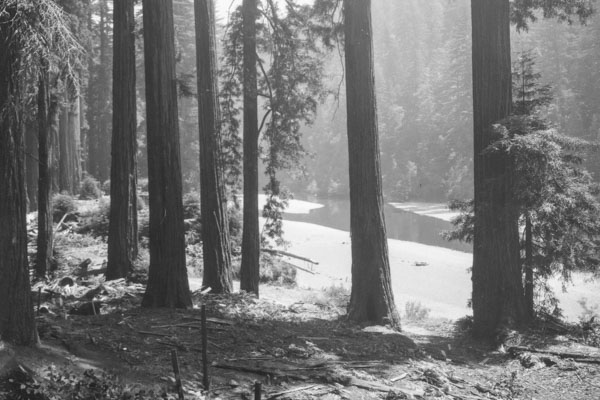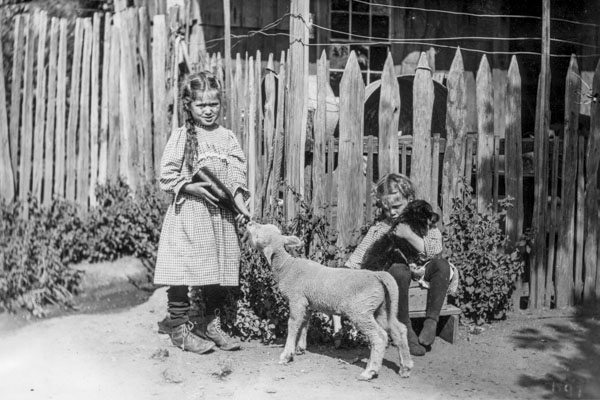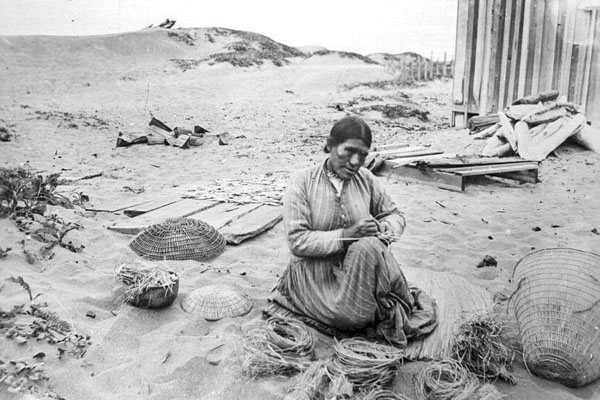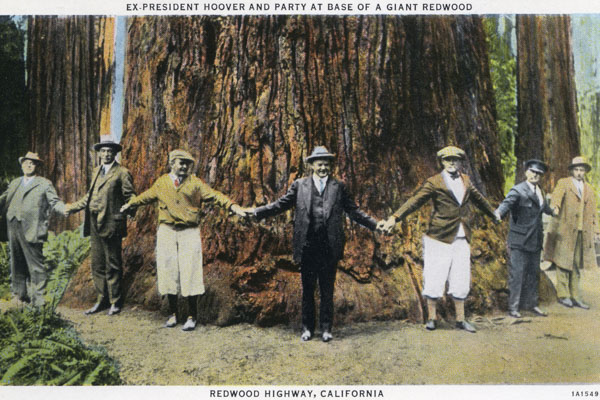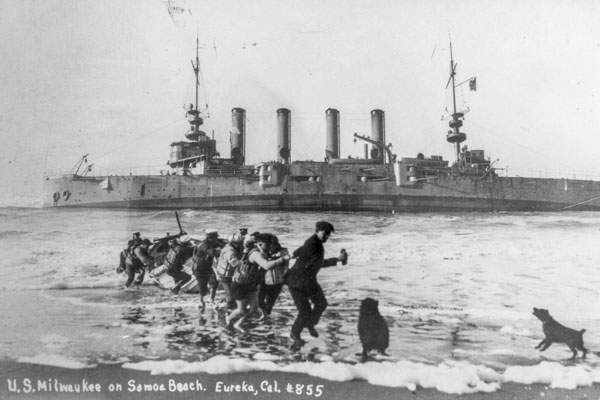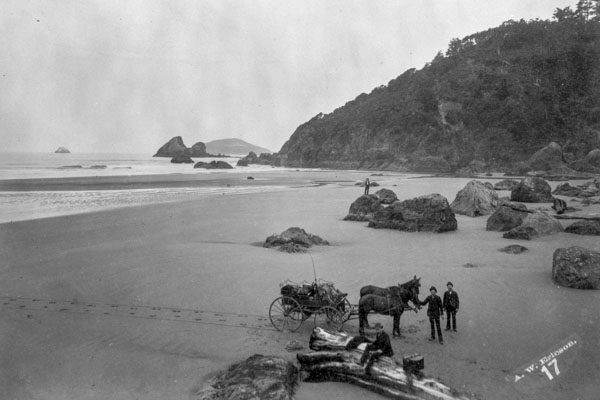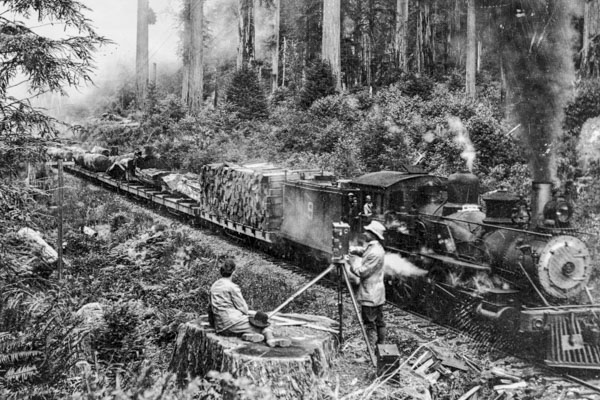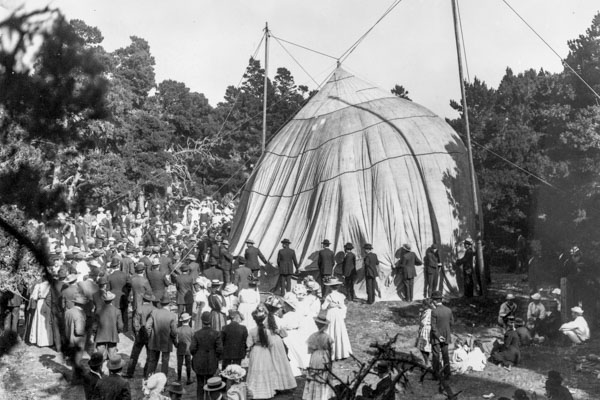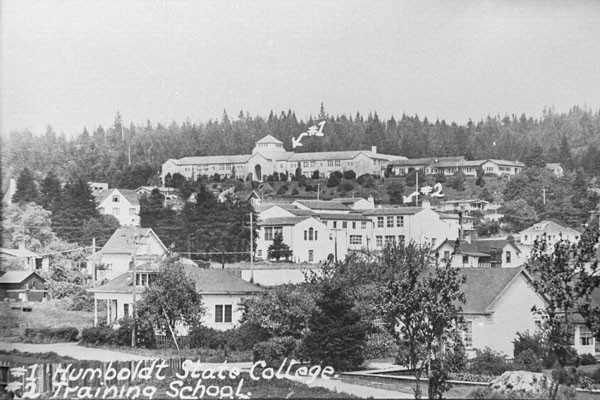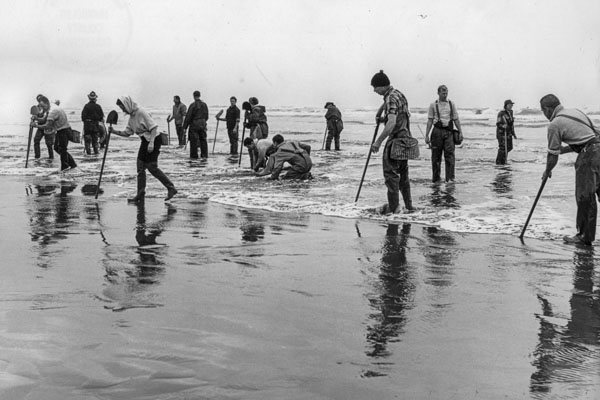You are here
Rekwoi Part I and Part II
Roberts, Ruth Kellet / "Rekwoi". Part I. Pacific Sportsman. March, 1934. Vol 14, No. 8, pp. 3-4, 31-32 and Part II. Pacific Sportsman. April, 1934. Vol 14, No. 9, pp. 2, 5, 25, 29, 31, 32
Seventeen years ago I stood one day with an old Yurok Indian woman in the Indian village of "Rekwoi" at the mouth of the Klamath River. The name Yurok has been incorrectly applied to the branch of the Algonquin Indians living from Weitchpec to Requa. Sa-atch is the Indian's own name for this group. Yurok is the Karok (Orleans Indians) name for this group.
The glorious stream, the Klamath River, has its source in Klamath Lakes, Southern Oregon, and flows for approximately two hundred miles through a narrow gorge to the Pacific Ocean, and empties at a point in Del Norte county, California, twenty-two miles south of Crescent City, and seventy miles north of Eureka. The Indians themselves called it O-meg-waw, meaning Big River.
The steep slope where we stood above the river, had once been a populous Indian community. All that now remained was one old family house, several caved-in sweat-houses, an equally caved-in ceremonial house, graves, and scattered pits overgrown with nettles where houses had once stood. Four Indian families, living in weather-beaten frame houses, were all that remained of the numerous inhabitants of the once thriving village.
We had stood for several minutes without speaking, looking across the tidewater lagoon toward the extinct Indian settlement on the opposite hill slope, the site of which was marked only by graves. Above the graves a conical hill, the "Mount Ararat" of Indian legend, stood guard. Suddenly my companion clutched my hand. Quick tears blinded her dim eyes as she exclaimed: "Too bad white man find this place! He never would, if old woman who lived right there hadn't let fire go out. She made a fog over fire. Hide this place! For long time no one found us! Oh, too bad!"
Again there was silence. In my heart I too, felt it was "Too bad."
The first white man to look out across the river and ocean from this same hillside slope was "Big John" Turner of the Jedediah S. Smith overland exploration party.
The Smith party, the first white "tourists" to invade this now popular fisherman's paradise, descended the Trinity and lower Klamath River canyons in 1828 and encamped on a flat on Hunter Creek, at a point somewhere near the junction of the Redwood Highway and the country road into Requa. This junction is one and one-half miles in from the mouth of the river.
In Smith's diary he states that during the short encampment of his party here, he saw no Indians. An Indian informant, however, related to me the fact that many Indians were hiding in the bushes near Smith's camp and observed, both day and night, every move made by the explorers.
"Big John" Turner, a man of enormous stature, was evidently the only member of the Smith party to go to the actual mouth of the Klamath River. Smith's diary does not recount this fact, but the Indians do. They have given me a complete description of Turner and the effect upon the Indians of the sudden appearance of this huge bewhiskered white man, who came alone into the Indian village at "Rekwoi" and stood quietly looking out across the Klamath River mouth and the Pacific Ocean.
The first impulse of the Indians, I am told, was to kill this intruder. His huge size and calm fearlessness, however, were so disconcerting to the Indians, that they concluded this stranger must have a "medicine" or "power", and that it might not be safe to kill him. And so, the first white tourist, who came "just to look around", "looked", and returned to camp, quite unconscious of his imminent danger.
The next arrivals at "Rekwoi" came by boat. In 1850 a small bark, the Laura Virginia, anchored just outside the mouth of the Klamath River. This boat was one of several boats outfitted in San Francisco, carrying miners seeking a water route to the Trinity goldfields.
Maps in use at the time indicated a large navigable stream, identified as the Trinity River, emptying into Trinidad Bay. It was believed that this river was a direct route to the Trinity gold fields.
The Laura Virginia, failing to find this river at Trinidad Bay, sailed on up the coast, and discovering the Klamath River, concluded it must be the sought for water route. Therefore, some of the miners and their supplies were put on shore at the mouth of the Klamath, where a temporary camp was set up on the north beach.
The dismayed Indians watched the Laura Virginia sail off up the coast and viewed with apprehension the camp preparations of the miners. The intent of these white trespassers was unknown to the Indians, but after observing the unwelcome immigrants for a time, decided they were not hostile, and so indicated the desired trails in order to rid the community of an undesirable foreign element.
The Indians called these new people the "Wa-gay", because they had sprung up from nowhere, and were "smart". The "Way-gay", a prehistoric people, were, according to an old Indian legend, the first people to inhabit this region, and "knew everything".
One inquisitive small boy, "Billie" Brooks, and his sister, bolder then the rest, went down to the camp fires of the miners and were treated to baked potatoes. "God, but they tasted good," Billie, the oldest surviving Indian living at "Rekwoi", said, in recounting the story to me, eighty-one years after the incident had transpired.
It was these miners from the Laura Virginia who first followed the course of the Klamath River for about one hundred and fifty miles to the Shasta River and made known the fact that the Klamath did not empty into the ocean at the mouth of the Rogue, as all maps up to that time had represented its course, but was a continuation of the stream which was known as the "Klamet" above the Shasta River, and had been frequently visited by trappers and settlers who journeyed between Oregon and the bay region of California.
For a period of years, miners and a few prospective settlers struggled through the lower Klamath River region, but made no settlement near the mouth of the river. The first and only building erected in the Indian village of "Rekwoi" by a white man was a store built and conducted by a man by the name of Weigle. The building housed the trader's family, a post office, a general merchandise store, a saloon and a community dance hall. Another man named Tucker succeeded the first occupant and the house, and it became known as "Tucker House." The woman-shaped rock at the river mouth became known as "Tucker Rock."
Several years ago an enterprising young Indian, Hathaway Stevens, acquired the property on which the old house stood, razed it and established himself and family in a modern bungalow. He "put in garden," leveled off a parking place for automobiles and prepared to harvest his share of profit from the ever-increasing tourist crop.
The town of Requa, the Mecca for salmon trollers from July until November, snuggling on the hillside about a mile in from the ocean, had a saloon as a nucleus of settlement, and from all reports outrivaled the frontier towns of the movies in local color. The name Requa is the white man's attempt at the use of the unfamiliar Indian name "Rekwoi", which in Indian means "river mouth."
Requa flourished as a prosperous center of business activity and boasted several saloons, two dance halls, two general merchandise stores, a post office, livery stable, cannery and shake mill, until a few years ago when most of the business activity, the fights and the dust of the tourist moved three miles out to the new town of Klamath, near the Douglas Memorial Bridge on the Redwood Highway. The old town of Requa, clinging to the hillside, with its comfortable inn, church, quaint cabins and cottages surrounded by gorgeously hued dahlias and sweet peas, seems more like a fishing hamlet in Europe than a California town.
Fishing has always been the consuming occupation of this community from the days of the unmolested aborigines who fished with every manner of net, spear, bone hook and trap, to the familiar commercial net fisherman, and the tourist sportsman with troll and casting rod.
Commercial fishing was introduced on the Klamath River by Mr. A. Bomhoff in 1887, who by agreement with the soldiers in charge of Indian affairs for this district, built a salmon cannery at the present site of the Klamath River Packers Association plant, with the understanding that only Indians were to be employed as fisherman and for unskilled labor. It was because of this agreement that the Indians and the Hoopa Indian agent permitted the cannery to be built on Indian land. Some of the Indians who started work in the cannery in 1887 were in 1933 employed there, and opening day each season found them knife in hand in their accustomed places ready for work. Commercial fishing was made illegal by action of the State Legislature of 1933 and the law became effective January 1st, 1934.
The commercial cannery during its six weeks of operation was the center of community activity. Indian families came down from "up river" in dugout-canoes, skiffs, and motor boats and established themselves for the fishing season in the cannery cabins near the plant. With their arrival, the sleeping hillside slope became alive with babies, dogs, white washings and men busy at their net racks putting their nets in order.
Young and old Indians of both sexes fished and worked in the cannery. Gossiping old women, too old to work, took care of the babies and busied themselves gathering and smoking salmon heads and tails salvaged from the cannery for winter food.
In the evening, Indians, local whites, and tourists gathered at the cannery platform or perched on points of vantage above the river, from which good view could be had, and watched the fishermen "lay out."
At the signal whistle from the cannery the fishing boats pulled out from both shores of the lagoon, the gill-nets stretching out behind with the "corks" bobbing on the surface as the boats raced toward the center of the stream. It was a thrilling sight.
Gill-net fishing on the Klamath River in recent years was legally confined to the two mile stretch between the mouth and Douglas Memorial Bridge, and was done only at night, six nights a week, over an actual period of about six weeks.
At the end of the commercial season, September 6th, the Indians had a grand finale in the way of a "brush dance", a "white man's dance", and a general holiday from all restraint. They "settled up", bought their winter food supplies and clothing, and returned to their homes up the river. Here they harvested their beans, potatoes and corn, gathered acorns, went hunting, and dried salmon. To the tourist salmon means sport fishing, to the Indian his staff of life.
Gill-net fishing was a game of chance. The salmon enter the river only during the daytime. If the fish come in on a morning tide, they are apt to move on up the river without delay. They may, however, go out again to return on the next incoming tide, or may move about or lay in pockets in the lagoon.
The net fisherman might or might not have been lucky enough to "lay out" in the place where the salmon happened to be, or, as is often the case, the salmon either did not come in or else went straight up the river. One boat might be "skunked" and another came in with five hundred pounds or more of salmon.
The sportsman's chance at the salmon is by casting from the shore, anchoring in the channel at the mouth of the river on an incoming or outgoing tide so that the current works the spinners, or trolling about in the lagoon. This past season "snagging", by throwing a line with a series of hooks attached, into the channel and drawing it quickly to shore was resorted to when the temperamental salmon refused to take the spinner. This can scarcely be called good sportsmanship. The anchoring method is the most popular, but there is better sport in casting from the shore or trolling in the lagoon, as this affords better opportunity for playing the fish. Anglers casting into the channel at the mouth of the Klamath are quite outspoken in their belief that this method of fishing for salmon is the most sportsmanlike, and look with utter contempt upon the fellow sitting in boats anchored in the channel, with either the outgoing or the incoming tide turning their spinners. Both groups rail loudly at the "sportsmen" cruising about the shallow tidewater-lagoon frightening the fish with the noisy "kickers" on their boats.
(to be continued in April issue)
Where Dreams Come True
[photo]
Klamath River
American's premier trout stream, with fighting fish anxious for combat.
[photo]
Yurok Indian girl wearing ancient tribal costume. Courtesy of Jones Studio, Crescent City, Calif.
[photo]
The author with a 47-pound Chinook salmon caught in the Klamath.
[photo]
Yurok Indian child in "trunk basket."
[photo]
Looking at Klamath River from mouth.
[photo]
A Yurok Indian wearing Brush Dance headdress.
The author, Ruth Kellett Roberts, a graduate of Mills College, Oakland, has spent seventeen summers at Requa, Del Norte County, California; has camped and fished with an Indian woman guide along the Klamath River, and in the back country of both the Klamath and Trinity River regions. She is thoroughly informed concerning the life and habits of the Indians of this area, as well as being an expert angler.
An article by Mrs. Roberts, "Conservation as Formerly Practiced by the Indians in the Klamath River Region," appeared in the California Fish and Game Magazine for October, 1932.
Indian boat pullers are always available for trollers, and it is much safer for an inexperienced boatman or one unfamiliar with the currents of the river to employ a native boat puller than to venture forth alone. During the trolling season it often occurs that some boat in "suicide row" (the boats anchored in the mouth nearest the breakers) is carried out by the current and overturned. The Indians have made some very spectacular rescues of these tourists.
Besides the one commercial fish cannery, which is now closed, several small Salmon canneries operate at Requa as a convenience to anglers who are thus enabled to have their catch canned, labeled with their own name and date of catching, and the cans either shipped or taken home as souvenirs.
The lower Klamath River region was thrown open to homesteaders in 1892 and white men wedged their way into the fishing industry, first as partners to Indian fishermen, and later, as regular fishermen. The entry of the whites as independent competitors was not accomplished, however, without battles on the river between Indians and whites. The management of the canning company at Requa always gave preference to Indians both as fisherman and as cannery workers.
The site of the present cannery is just below the old Indian village called Temeri, which was occupied by several families, including Annie Hodge, Kitty Gensaw, and the late Captain Jack, who until his death several year ago, was a familiar figure about town. He is said to have been a scout for General Grant.
Another distinctive personage in pioneer history in this region was Captain Spott, who was head man of "Rekwoi." His acquisition of the title of Captain came about in an interesting way. The Indians observed that there was a "head man" on the boat that brought freight to and from the cannery, and that he was called Captain Scott. The Indians explained that they too had a "head man," a captain and thinking that the name Captain Scott was the English word used to designate the leader, tried to call their "head man" Captain Scott, but their actual pronunciation was Spott. His son, Robert Spott, who was intrusted with the lore and legends of his people by the old captain, was recently called to the University of California as an informant in the Department of Anthropology by Dr. A. L. Kroeber. Robert Spott is a most unique figure and stands out as an aristocrat in the culture of his own race, yet taking his place with perfect poise in the white man's civilization.
Commercial fishing until recent years occupied the local stage on the lower Klamath River and sport fishing for Salmon and Steelhead Trout had not been thought of. Dr. J. O. Snyder of Stanford University and Chief of the Bureau of Fish Culture for the State Fish and Game Commission, who in 1919 started his biological survey of the Salmon and Trout run on the Klamath River, was the first to attempt casting for Salmon. He was convinced that there was every reason to expect results, but inasmuch as no one had previously attempted it, allowed himself to be laughed out of continuing the experiment. To the late George Field, then manager of the Klamath River Packers Association, is conceded the honor, in 1920, of taking the first Salmon with a spinner.
For years the lower Klamath River was so muddied by suspended silt from hydraulic mining on the upper Klamath, Trinity and other tributaries of the Klamath, that casting and trolling for Steelhead and Salmon were practically impossible. Because of a cessation of this type of mining the river has cleared, and this fact, coupled with the construction of the Redwood Highway which crosses the Klamath near its mouth, has brought thousands of tourists and sportsmen to this region, particularly in the last four years, for trolling for Salmon in the lagoon at the mouth of the river. Fly fishing for Steelhead is done on the riffles further up the river, although a few are taken at the mouth with spinners while casting and trolling for Salmon. Some fishermen have better success in taking Steelhead on the riffles with a spinner. The spoon type of spinner is the only one that is successfully used for taking Salmon or Steelhead on this stream. Salmon do not take any food after entering fresh water and therefore the use or inclusion of bait in any form in the angler's equipment only impairs the effectiveness of the lure.
Two different species of Salmon are native to the Klamath River, the Chinook, also known as King and Tyee, and the Silverside or Cohoe. The Chinook, the largest of the five species of Salmon caught on the Pacific Coast enter the river in the early Spring and continue into November. This is larger than the Silverside run. Salmon and Steelhead are most plentiful during the months of August, September and October, and it is during this time that the disciples of Isaac Walton are in their glory.
The Chinook enter the river to spawn at from two to six years of age. The greater part of the run, however are four year old fish. The two year old fish entering are practically all males, fully developed, and they go on up the river to spawn and die as do the older Salmon. Chinook Salmon caught by the tourists run from four to fifty pounds in weight, the average being around fifteen pounds.
Silverside Salmon start running the first of September and continue to enter the river until January. These fish spawn at two to three years of age, and are a much smaller fish than the Chinook. The average Silverside weighs between eight and ten pounds.
Both the Chinook and the Silverside Salmon are considered game fish, and put up a furious fight when hooked.
The Steelhead, the famous sport fish in the Pacific Coast streams, a sea run trout, is also native to the Klamath River and can be found throughout the entire year. There are, however, two large Steelhead runs. One, called the summer run, starts in August and continues until spring. Steelhead caught by the tourists average from one to ten pounds. Occasionally a larger one is taken and net fishermen have in past years caught Steelhead weighing over thirty pounds.
It is claimed that Salmon taken at Requa are very much finer in color and flavor than those taken further up the Klamath River. As already stated, Salmon do not eat after entering the stream to spawn and, as the eggs develop, the intestinal tract becomes almost entirely absorbed. Salmon deteriorate very rapidly as they ascend to the spawning grounds, where, their life cycle completed, they spawn and die in the stream in which they were born. The Steelhead on the contrary, remain in good condition and spawn and return to the sea, to return again and again to spawn.
Fish and game regulation and enforcement of laws designed for conservation of natural resources have not been as effective in this region as the old Indian customs and law enforcement. The Indian took fish and game for food only and never for the sport of killing. He never took more than could be used and no edible parts were wasted. Even the entrails were dried for winter food for dogs. No Indian of the old civilization was other than reverent in the taking of a food supply and in careful observation of all the laws governing it, as laid down by the "Creator."
The "Creator," according to Indian legend, designed the topography of this country, making many changes in it, as indicated by shell deposits on mountain tops, and other nautral [sic] phenomena, and working on it until "it looked nice to Him." Then "He" made the fish and observed them as they came into the river from the ocean; next "He" devised all the ways of fishing, by net, spear and traps; made the laws governing the taking of fish; and fixed the time of seasonal entrance into the river for the various kinds of fish. After the "Creator" worked out all the habits of the fish, devised all the methods of catching them, and made the laws governing the taking of all fish and game, "He" taught these laws to the Indians. Violation of any of these laws, it was believed, would be followed by "loss of luck" or death within a year.
The entrance to the Klamath River is marked by two sister rocks. The one standing on the north shore looks like a woman with a burden on her back. The other is a large biscuit-shaped rock at the base of the opposite slope on the south side of the flood plain. At their bases the "Creator" placed fishing rocks with identical names, Ah-lee-erk, as guides to the entering fish. These rocks mark the extremes of the shift of the river in its course at the mouth. Two sand-spits stretch between the lagoon and the ocean, and the river mouth cuts through at changing points. The sand-spits, the Indians believe, are really the legs of the sisters, and the shift of the mouth is caused by the drawing up of one or the other pairs of legs, thus changing the length of the sand-spits between the lagoon and the ocean.
Sometimes in the fall of the year when the river is low the legs meet, thus closing the mouth. In the old days when this occurred, an Indian virgin about ten years of age, dressed in a beautiful buckskin costume, trimmed with shells, "trotted" across the sand bar and the river broke through and allowed the fish to enter.
The impatient white man, not understanding the "laws of the Creator" (nature), seeks by artificial means to open the mouth. The Indian regards this effort as an affront to the "Creator." "For," an Indian friend remarked, "He is not dead, but living and working all the time. It is against the laws of creation to tamper with the river or with the country. The Creator worked a long time to make this a beautiful and a good country to live in and only He should change it."
An Indian informant pointed out the rocks and told me their names; showed me where the sea lion was born; the "Creator's" couch in the rock where "He" rested; the flat rock where the dancer for the Jump Dance dressed before crossing to the other side of the river to continue the dance; the praying rock, A-Chwee-gee, where the Indians prayed before starting up the river for a "doctor"; the places where women must not pass; and where one must not eat; where the sea-birds nested; and told me how to pray to Oregos, if one were drowning so that she would bring a big wave to carry one to shore or a wave to keep enemy boats from landing. I learned to respect the laws of these places and to observe the age old taboos. Once in my early picnicking days I ate lunch on the wrong beach and the whole community was deluged in rain as a result. Old Indian women kindly reproved me for having brought on the rain which drenched their snow-white washings hung everywhere on the neighboring hillsides.
The Indians are disturbed over many liberties that are now taken with nature; over the noisy motor-boats which they declare, scare the fish; and over the ever increasing intruders who swarm over and defile the sacred places.
There is a name and a legend for every spot in this river region and many evidences of "The Creator's" presence here. It is a pity that some organization does not mark with their respective and appropriate Indian names some of the places rich in Indian lore while it is still possible to learn from the living Indians the names.
Perhaps it is too much to hope that glaring advertisements of merchandise may be removed from fine old rocks that they now deface.
I wondered how the Spanish name "Pacheco" found its way into this region into which Spanish settlers had not penetrated, in the name given to a rock inside the month [sic] of the river, called "Terper" by the Indians, and gleaned this explanation: Years ago a Spaniard, by the name Pacheco, seeking his way to the coast from the Trinity gold fields, became lost, and was befriended at Weitchpec by an Indian by the name of Weitchpec Frank. His wife, Mary Ann, had just finished baking some acorn bread on hot rocks on the sand bar, when her husband brought in the unexpected white guest. She was quite properly annoyed and upbraided her thoughtless spouse for inviting the white man to a meal she though he couldn't possibly eat. But he did, and remained, as a member of the family.
The next time Weitchpec Frank went to "Rekwoi" to visit his brother Captain Spott, he told him of the white man Pacheco. Captain Spott was quick to recognize the possible usefulness this man could be to him as a scribe. So Witchpec [sic] Frank brought him down to Captain Spott and until the time of Pacheco's death he lived in the Indian village of "Rekwoi," as a retainer of the old Captain, in a cabin on the river bank just opposite Pacheco Rock. The irony of the situation was that when the Captain wished a letter written to Washington protesting the encroachment of the whites upon his land, he discovered to his consternation that Pacheco could neither read nor write.
There is a charm about this quiet place that is indiscribably [sic] subtle, and a thing quite apart from the lure of sport fishing. True, there are hot dog stands on the sand spit; floating lunch counter "arks"; auto camps; improvised sport attire, fishing and camping equipment; evidences of both the crudity and refinements of the white man's vices; pretty, well dressed Indian flappers and well groomed youthful Indian Lotharios; but there is also a pure Indian culture here of a remnant of Algonquin Indians, who represent all that is left of the highest aboriginal civilization in California.
When the end of summer comes, I make a pilgrimage to Oregos, where I stood years ago with my good friend Mary Ann. I look out across the quiet lagoon with the pelicans and seagulls circling above, the fresh sea air in my face, and I know that I shall always return. For, did I not that first year eat eels and drink river water?
